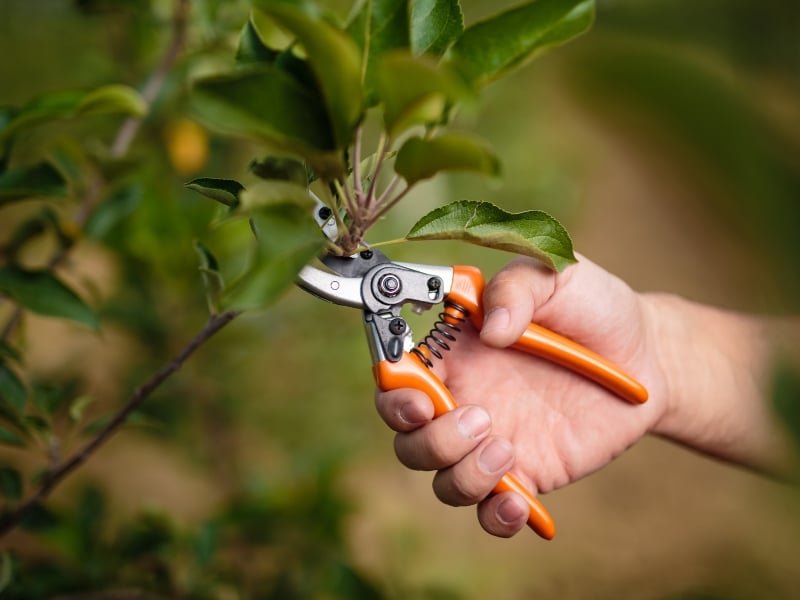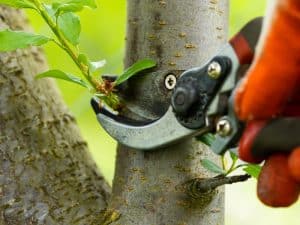Pruning is a crucial part of fruit tree care that influences growth, health, and productivity. Done correctly, it ensures trees develop strong structures, produce high-quality fruit, and remain free from disease. However, improper pruning can have negative effects, potentially harming tree growth and fruit yield.
This guide explores how pruning affects fruit tree growth and highlights best practices for Melbourne homeowners. Whether you’re a DIY gardener or considering professional tree services like The Yard, understanding pruning’s impact can help you make informed decisions.
What is pruning, and how does it influence fruit tree growth?
Pruning is the process of selectively removing branches to shape a tree, promote healthy growth, and improve fruit production. It involves cutting away dead, damaged, or overcrowded branches to maintain the tree’s structure and vitality.
How pruning influences fruit tree growth:
- Encourages new growth: Removing old wood stimulates fresh shoots and healthier branches.
- Improves sunlight exposure: Thinning branches allow sunlight to reach inner foliage, aiding photosynthesis.
- Enhances air circulation: Better airflow reduces the risk of fungal diseases, such as Myrtle rust (Austropuccinia psidii), and pests.
- Supports structural integrity: Proper pruning prevents weak branches that might break under fruit weight.
- Reduces competition: Trees direct energy toward fruiting rather than excessive foliage growth.
Pruning at the right time and in the correct way ensures your fruit trees remain strong and productive year after year.
Why does pruning boost fruit tree productivity?
Pruning directly impacts how much fruit a tree produces and its overall quality. Here’s how it improves productivity:
| Pruning Benefit | Impact on Fruit Trees |
| More fruit-bearing wood | Removes non-productive branches, allowing new buds to thrive. |
| Better fruit quality | Increases fruit size and sweetness by reducing overcrowding. |
| Disease prevention | Eliminates infected branches before they spread. |
| Stronger branches | Supports heavier fruit loads, preventing breakage. |
| Extended lifespan | Reduces stress, helping trees live longer and stay healthy. |
Regular pruning ensures that fruit trees channel energy efficiently, resulting in abundant and high-quality harvests.
Can improper pruning harm fruit tree growth?
Yes, incorrect pruning techniques can cause serious damage, leading to weak growth and poor fruit production. While over-pruning can stress trees and reduce fruit yield, it’s also important to explore why minimal pruning is better for the ecosystem and encourages natural growth, allowing trees to develop resilience and support local biodiversity.
Common pruning mistakes and their consequences:
- Over-pruning: Removing too much foliage can stress trees, leading to fewer flowers and fruit.
- Incorrect timing: Pruning at the wrong season can make trees vulnerable to pests and diseases.
- Improper cuts: Cutting too close to the trunk or leaving stubs can cause decay.
- Ignoring structural balance: Uneven cuts can weaken the tree and lead to breakage.
Signs of poor pruning:
- Slow growth
- Excessive water shoots (weak vertical branches)
- Sunburned bark due to lack of shade
- Increased susceptibility to disease
By using the right techniques and tools, you can avoid these pitfalls and ensure healthy tree growth.
Is there a difference between pruning young vs. mature fruit trees?
Yes, young and mature fruit trees require different pruning approaches to optimise their growth and productivity.
Key differences in pruning techniques:
| Tree Age | Purpose of Pruning | Best Practices |
| Young Trees | Establish structure | Shape the tree, remove weak branches, encourage balanced growth |
| Mature Trees | Maintain health and productivity | Thin out old wood, remove overcrowded branches, enhance fruit quality |
Pruning young trees helps form a strong foundation, while pruning mature trees focuses on sustained fruit production and disease management.
Who should prune fruit trees—DIY gardeners or professionals?
Many Melbourne businesses and property managers wonder whether they should prune fruit trees themselves or hire experts like The Yard. The choice depends on the complexity of the job and the tree’s health. Understanding your tree’s specific needs can help you decide whether to take a DIY approach or seek professional fruit tree pruning services in Melbourne.
DIY pruning is suitable for:
- Small, easy-to-reach trees
- Light trimming of dead or weak branches
- Basic maintenance after learning proper techniques
Regular DIY pruning can help with minor upkeep, but improper cuts may lead to long-term damage and reduced fruit production.
Professional pruning is recommended for:
- Large, mature trees requiring climbing or equipment
- Disease prevention and tree health assessment
- Structural pruning to prevent future damage
- Compliance with council regulations for protected trees
Experts use specialised tools and techniques to ensure precise cuts that promote healthy growth and maximise fruit yield, making professional pruning a smart investment for commercial properties.
Hiring an experienced arborist ensures safety, compliance, and optimal results for your fruit trees. If you’re unsure, consulting a professional can prevent costly mistakes and improve your tree’s longevity and productivity.
Are there specific pruning techniques for different types of fruit trees?
Yes, different fruit trees require specific pruning methods for maximum productivity. To achieve the best results, it’s essential to understand why different trees require unique pruning techniques and apply the right approach for each species.
Best pruning techniques for common fruit trees:
| Fruit Tree | Pruning Method | Benefits |
| Apple & Pear | Spur pruning | Encourages fruiting spurs for consistent harvests |
| Stone Fruits (Peach, Plum, Cherry) | Open-centre pruning | Improves airflow and sun exposure |
| Citrus (Lemon, Orange, Lime) | Light thinning | Maintains shape and prevents overcrowding |
| Fig & Pomegranate | Hard pruning | Controls size and enhances fruit set |
Proper pruning tailored to each fruit tree type ensures the best yields and healthiest growth.
Conclusion
Pruning is essential for maintaining strong, healthy, and productive fruit trees. When done correctly, it encourages growth, enhances fruit quality, and prevents diseases. However, improper pruning can lead to weak trees, reduced fruit yield, and potential structural damage.
If you’re unsure how to prune your fruit trees effectively, reach out to the experts at The Yard through their contact page to discuss the best pruning solutions for your trees.



